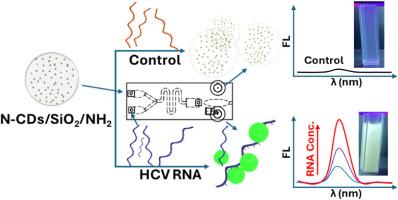当前位置:
X-MOL 学术
›
Anal. Chim. Acta
›
论文详情
Our official English website, www.x-mol.net, welcomes your
feedback! (Note: you will need to create a separate account there.)
Microfluidic-based fluorescence enhancement of silica-embedded carbon dots for direct detection and quantification of unamplified HCV RNA in clinical samples
Analytica Chimica Acta ( IF 5.7 ) Pub Date : 2024-11-07 , DOI: 10.1016/j.aca.2024.343396 Hanan Shaat, Mohamed Sharafeldin, Amany Mostafa, Eman H. Ismail, Mohmed K. Hassan, Mohamed H. Alkordi, El-Zeiny M. Ebeid, Hesham Elghazaly, Sara H. Agwa, Sherif M. Shawky
Analytica Chimica Acta ( IF 5.7 ) Pub Date : 2024-11-07 , DOI: 10.1016/j.aca.2024.343396 Hanan Shaat, Mohamed Sharafeldin, Amany Mostafa, Eman H. Ismail, Mohmed K. Hassan, Mohamed H. Alkordi, El-Zeiny M. Ebeid, Hesham Elghazaly, Sara H. Agwa, Sherif M. Shawky

|
Hepatitis C Virus (HCV) is an asymptomatic chronic infection with serious clinical consequences. Timely and sensitive detection of HCV RNA is critical for infection control, treatment response follow up. While current technologies, such as PCR or isothermal amplification-based strategies, are specific, they are expensive, labor intensive, time consuming limiting their use in field and small laboratories.
中文翻译:

基于微流控的硅胶包埋碳点荧光增强,用于直接检测和定量临床样品中未扩增的 HCV RNA
丙型肝炎病毒 (HCV) 是一种无症状的慢性感染,具有严重的临床后果。及时灵敏地检测 HCV RNA 对于感染控制和治疗反应随访至关重要。虽然当前的技术(如 PCR 或基于等温扩增的策略)是特定的,但它们价格昂贵、劳动密集、耗时,限制了它们在现场和小型实验室中的使用。
更新日期:2024-11-07
中文翻译:

基于微流控的硅胶包埋碳点荧光增强,用于直接检测和定量临床样品中未扩增的 HCV RNA
丙型肝炎病毒 (HCV) 是一种无症状的慢性感染,具有严重的临床后果。及时灵敏地检测 HCV RNA 对于感染控制和治疗反应随访至关重要。虽然当前的技术(如 PCR 或基于等温扩增的策略)是特定的,但它们价格昂贵、劳动密集、耗时,限制了它们在现场和小型实验室中的使用。

































 京公网安备 11010802027423号
京公网安备 11010802027423号